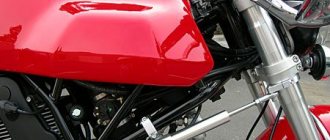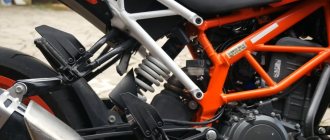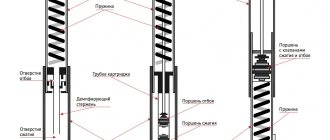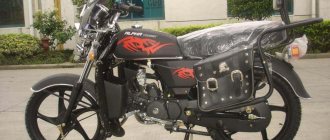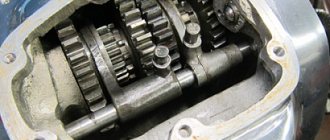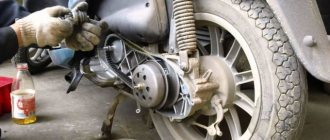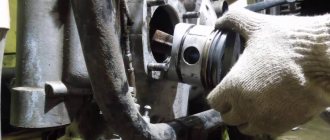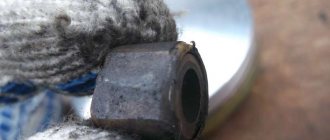Front fork M 72
The front fork consists of a telescopic body, a shock-absorbing mechanism, a steering mechanism and a steering shock absorber.
The telescopic housing consists of two steel pipes placed inside housings 1 and 2 and connected to each other by a crossbar 4 and a steering column bridge 5, in which the steering column rod is pressed.
Using a bridge, the fork is connected to the motorcycle frame.
Tubular tips 7 and 8 are installed on the ends of the pipes on bearings 9 and 10. The lower bearings 10 are restrained by retaining rings.
The pipe traverses are secured with nuts 12 and clamped in the split sockets of the bridge using bolts.
Covers 3 and 6 with brackets for mounting the headlight are placed on the upper part of the bridge stays 5.
Return to contents — ↑
content .. 21 22 29 ..REPAIR OF CREW PART AND ELECTRICAL EQUIPMENT OF MOTORCYCLES “DNEPR” AND “URAL”
DISASSEMBLY AND ASSEMBLY OF THE FRONT FORK OF MOTORCYCLES “DNEPR” AND “URAL”
To disassemble the stay (Fig. 61), unscrew the nut 17 securing the fork leg tube to the yoke 19, slightly pull the shock absorber rod upward, loosen the lock nut of the rod and unscrew the nut from the shock absorber rod. Insert the front axle into the tip of the fork leg and use a ring wrench to unscrew the oil seal housing assembly 24. Remove the fork leg tip down from the fork leg tube along with the shock absorber 4 and spring 7. Remove the spring ring 12 securing the lower bushing of the fork leg pipe 9, the lower and upper bushings fork leg pipes and oil seal assembly. Unscrew the nut of the bridge coupling bolt 16 by 2...3 turns and pull down the fork leg tube (to make it easier, screw the tightening nut onto the end of the fork leg tube by four to five threads and knock the pipe out of the traverse cone with light blows of a rubber hammer).
To disassemble the shock absorber, unscrew the bolt securing the shock absorber housing cone 4 at the bottom of the fork stay, remove the shock absorber washer 15 and the sealing washer 18 under the bolt, remove the shock absorber 4 assembled with the spring, and unscrew the upper nut on the shock absorber rod and spring and the upper tip. Then remove the spring, unscrew the shock absorber tube nut and remove rod 5.
First fork tip
during repair may have the following defects:
- dents on the pipe - straighten the pipe until the defect is eliminated;
- failure of threads on a pipe of more than two threads - replace the pipe or repair it, grind off the threads, scald the surface, grind and cut threads of normal size M48X1.5;
— wear of the surface of the fork leg tip pipe hole under the lower bushing to a diameter of more than 42.2 mm (for Dnepr, Ural M-66 and M-67-26 motorcycles) and more than 37.2 mm (for Ural motorcycles) M-62 and M-63) - process the hole to a repair size of 42.5 mm for the repair sleeve;
— failure of the threads of holes in the tip of more than two threads — drill holes, boil, drill and cut threads of normal size, M18X1.5 (left) and MB, respectively, weld cracks; when the ears of the base at the left tip of the pen break off
forks - weld them and process them to normal size.
Steering column rod
with the bridge assembly during repair may have the following defects:
- cracks, broken rod or bridge of any size and location - replace the part;
— bending of the steering column bridge in the places of transition to the fork leg mounting hubs is more than 0.02 mm over a length of 100 mm — straighten the bridge until the bending is eliminated;
- wear of the surface of the bridge journal under the angular contact ball bearing to a diameter of less than 33.95 mm - chrome plating the surface and grinding to the normal size of 34 mm. It is allowed to weld and process the neck to normal size;
- loose fit of the steering column rod - if the surface of the rod is worn to a diameter of less than 28.100 mm, its surface should be chromed and ground to a normal size of 28 mm or repair dimensions of 28.2; 28.4 mm (repair dimensions are allowed only when eliminating the defect by welding the surface). If the surface of the bridge hole is worn to a diameter of more than 28.05 mm, weld the surface and process it to the normal hole size of 28 mm. It is allowed to machine the hole to repair dimensions of 28.2 and 28.4 mm for the steering column repair rod;
- wear of the bridge pin under the steering shock absorber washer to a diameter of less than 11.7 mm - replace the pin;
- threads on the rod are broken by more than two threads - replace the rod;
- weakening of the fit of the pins in the holes of the bridge - if the threads in the holes of more than two threads are broken, replace the defective pin with a new one; If more than two threads are broken, drill a hole and cut a thread of repair size M10X1 for the repair pin.
Right casing
the assembly during repair may have the following defects:
— broken front brake cable holder, shield mounting ear, turn signal mounting bracket — replace the defective part;
— cracks in the headlight bracket or housing stocking — weld the cracks and clean them flush with the base metal;
- dents more than 1.5 mm deep - straighten the casing until the unacceptable dents are eliminated;
- crushing and crumbling of the teeth of the headlight bracket washers, more than four in number - replace the defective washer.
Front wheel guard
the assembly may have cracks and dents during repairs - weld the cracks and clean them, straighten the dents. For Ural motorcycles M-63, M-66 and M-67-36, if the rubber part of the shield breaks, it is allowed to apply a patch to the glue on the inside.
Fork leg tube
made of steel pipes (steel 35) and has a hardness of HB 200-240. During repairs it may have the following defects:
— the bent of the fork leg tube is more than acceptable (mutual runout of the surfaces is allowed no more than 0.1 mm)—straighten the tube until the bent is eliminated;
- wear of the pipe surface to a diameter of less than 36.75 mm - chrome the surface and grind it to the normal pipe size of 36 mm, for the Ural M-62 and M-63 motorcycles the normal pipe size is 35 mm;
- wear of the conical surface under the traverse (it is permissible for the conical gauge (ring) to be no more than 30.95 mm long) - scald the surface and process it to the normal size of the cone;
- wear of the surface under the lower bushing to a diameter of less than 30.9 mm (only for Ural motorcycles M-62 and M-63) - chrome the surface and process it to the normal pipe size of 31 mm;
- thread failure in a pipe of more than two threads - drill a hole, weld, bore and cut a thread of normal size M27 mm.
Oil seal housing
made of steel 35. During repairs it may have the following defects:
- cracks of any size and location - replace the housing;
- thread failure of more than three threads - replace the body;
— wear of the hole surface to a diameter of more than 4.7 mm—weld the hole and drill to a normal size of 4 mm (it is allowed to drill new holes in the spaces between the old ones, which are welded and cleaned).
Traverse
made of steel 35 or 45. During repairs it may have defects:
- cracks of any size - replace the traverse;
- bending is more than 0.2 mm over a length of 100 mm - straighten the traverse until the bending is eliminated;
- wear of the surface of the hole for the bearing nut to a diameter of more than 32.15 mm - weld the hole and process it to the normal size of 32 mm;
- wear of the conical surface under the fork leg tube, sinking of the conical gauge by more than 0.2 mm from the nominal position - scald the surface and process it to normal size.
When the surface of the hole in the shock absorber body tube for the piston and guide is worn to a diameter of more than 16.2 mm, the hole is machined to a repair size of 16.3 mm for the repair piston and repair guide. Repair parts are made of steel 35.
Assembly.
Reassemble the front fork in reverse order. Before assembly, all parts are thoroughly washed in kerosene. Particular attention is paid to the cleanliness of the internal cavities of pipes, tips, fork legs and cylinders. After preliminary assembly of the shock absorber body cone with the pipe, check the perpendicularity of the end of the cone relative to the tube. Non-perpendicularity is allowed no more than 0.15 mm over a length of 100 mm. If necessary, the end of the cone can be mechanically processed, and the length of the pipe assembled with the cone must be at least 202 mm. The gap between the shock absorber piston and the body tube should be 0.06...0.55 mm, between the lower shock absorber guide and the tube - 0.12...0.5 mm, and between the rod and the hole in the pipe nut - 0.35...0.7 mm. The rod nut is screwed onto the rod until it stops. In this case, the size from the end of the rod to the end of the nut must be at least 32 mm. Nominal dimensions, tolerances, clearances and tensions in the main mating parts when assembling the front fork are presented in Table 24.
After installing the rod with the piston and guide into the body pipe and installing the shock absorber pipe nut, the rod should move freely, without jamming. The gap between the upper bushing of the fork leg and the pipe should be 0.075...0.36 mm, between the lower bushing of the fork leg and the tip - 0.025...0.25 mm. Pipes assembled with bushings must move freely inside the mating tips assembled with shock absorbers and bushings (check before installing the seal assemblies). The gap between the tip of the upper spring and the nut should be 0.2...0.5 mm. The seal assemblies are installed on the tips of the feathers on thickly grated red lead. When installing the oil seal housing onto the airfoil pipe, a mandrel is used. After assembly, check the fork legs for leaks under a pressure of 50 kPa for 10 s by immersing the forks in water. Air leakage at the connection points is not allowed. Do not add oil to the fork before testing. During the test, no more than two or three air bubbles are allowed to appear from under the seal. The permissible difference in the lengths of the left and right feathers is no more than 2.5 mm.
Before screwing the tightening nut securing the fork leg pipe into the yoke, screw a plug or screw to drain the oil. 135 cm3 of engine oil is poured into the fork leg pipe from above.
When tightening the tightening nut to ensure a tight fit of the cone connection in the fork crossmember, loosen the nut of the fork bridge coupling bolt and tighten it after tightening the tightening nut.
content .. 21 22 29 ..
Front fork shock absorber
The shock-absorbing mechanism consists of springs 11 of a hydraulic shock absorber, designed to dampen fork vibrations and provide reliable shock absorption during strong shocks.
The hydraulic shock absorber consists of a rod 4 with a check valve 2 and a tube 1 with a bushing 3.
The rods have sharpenings at the ends.
Check valves 2 can move along the rods, and there are annular gaps between the inner surfaces of the valves and the rods, since the diameter of the check valve holes is larger than the diameter of the rod.
In this case, when the valve is pressed against the rod guide, the annular gap closes.
Bushings 3 are designed to guide the rods and dose the oil passing through the annular gap during shock absorber operation.
90 cm3 of oil is poured into each tube through plug 12. The oil enters the tip reservoir and through holes a enters the tubes 1 of the shock absorbers.
How does the M 72 shock absorber work?
The hydraulic shock absorber works as follows.
With smooth pushes, the movable tips of the feathers move upward, thereby reducing the volume of the oil reservoir in tube 1. The oil presses on the check valve, opens it, passes into cavity c and partially flows out through hole a.
During sudden shocks, oil does not have time to flow out of the shock absorber tube, creating resistance to the upward movement of the fork. This provides additional cushioning.
Compressed coil springs 11 throw the movable fork feathers down. In this case, the check valve closes, and the oil is squeezed out into the oil reservoir through the annular gap b and through the gap between the outer surface of the valve and the tube.
Return to contents — ↑
Motorcycle front fork - different designs.
The front fork of a motorcycle is one of the main parts of any bike and not only a comfortable ride on our “beautiful” roads depends on it, but also, along with a motorcycle frame, a motorcycle fork is the main component of any bike, responsible for the beautiful silhouette and design of the motorcycle as a whole . In this article, intended more for beginners, I will try to describe the design of almost all designs of motorcycle forks, from the most common telescopic fork to the most exotic designs that are now conquering the market thanks to the now fashionable trend in customization, in the old school style.
Motorcycle front fork - different designs.
Telescope - there’s so much in this word!
Let's start with the most common front fork design - telescopic. Forks of this design have long been installed on almost all modern production motorcycle models. The Danish company Nimbus was the first to use such a design back in 1919, on its motorcycle shown in the photo on the left.
Further, in the pre-war 30s of the last century, the BMW company began installing a telescope on its BMW R-35 motorcycle models. Moreover, the very first models of telescopic forks were dry, that is, they did not have a hydraulic system. A little later, hydraulics were used, which made it possible to dampen the vibrations of the fork legs and the ride became more comfortable.
The design of the simplest telescope is not at all complicated and the main parts are movable pipes that slide in bushings located in fixed pipes (feathers). The presence of bushings that can be replaced as they wear out makes the telescopic fork quite durable, since the bushings wear out faster than the pipes themselves and can be replaced with new ones at any time.
I have already written about the design, maintenance and repair of the simplest domestic telescopic fork in this article, and those interested can read about the maintenance of a more modern inverted type fork (and replacing the oil seals on such a fork - see photo below). Well, I advise you to read how and with what help to correctly align the bent stays of a telescopic fork here, I hope it will be useful to many.
The old oil seal, boot, washer and retaining ring removed from the fork.
A further development of telescopic forks in the 80s of the last century was the ability to fill them with compressed air (for example, on the Chezet crossovers of the 80s, or on the licensed IZH Planet 5 fork). This made it possible to adjust the fork to the desired weight and road conditions. But the most advanced designs for adjusting compression and rebound strokes began to appear in the 90s of the last century, on sports motorcycles for road racing.
In those same years, engineers did not stand still and thicker movable pipes began to be installed at the top, not at the bottom, and these thicker fork pipes became stationary - and this is how the inverted fork appeared - the modern inverted telescopic fork. The installation of thicker and more rigid tubes at the top of the triple clamps made the telescopic fork more torsionally rigid, which significantly improved the bike's handling and comfort at high speeds.
This design began to appear not only on sport bikes, but also on modern cross-country bikes and then moved on to serial road motorcycles and street fighters. Later, the shifter began to appear even on some serial choppers or cruisers (Yamaha XV 1700 Warrior, Suzuki Desperado, Suzuki VTX, Triumph Rocket III, etc.)
The design of more modern inverted telescopic forks, which are installed on modern sportbikes and cross-country motorcycles, is a little more complex and uses a system with which you can adjust the rebound or compression stroke.
This allows you to adjust the front fork of the motorcycle to the rider's weight and road conditions, and allows you to tune the bike's handling. In addition, the most modern forks now have an anti-dive device that allows you to eliminate the motorcycle’s dive during sudden braking.
I will not analyze in detail here the design of such forks and how their systems work, otherwise the article will turn into an immense canvas (somehow I’ll find time and write a separate article). By the way, I wrote in detail about adjusting the suspensions - front and rear, in order to restore normal handling of a modern motorcycle, in this article.
It would seem that the modern inverted telescopic fork is the ideal that motorcycle engineers and all motorcyclists in the world have strived for, and forks of other designs are destined to sink into oblivion, and are left to vegetate only in motorcycle museums around the world.
But no, the more ancient forks would have withered away in motorcycle museums if it weren’t for customization and the now fashionable trend - old school - the old school of customization, which has won the whole world with its popularity. And so we are gradually moving on to more exotic models.
Front fork of a springer motorcycle (springer is a chopper rider's dream).
Such beautiful things (as the late Indian Lari said) appeared quite a long time ago, almost on the very first motorcycles. But still, the first customs and beavers with such forks began to be made based on forks from the legendary military “Valuya” (Harley Davidson WLA).
With modification and chrome plating, such a fork will decorate any chopper. And the now popular old-school style choppers are generally unthinkable without a springer. Of course, there are other worthy and interesting fork designs that can be decorated with a custom in the old school style, but more on them a little later.
But the most important advantage of the springer, in addition to its beautiful appearance, is the ability to work normally at extreme fork angles, at which the telescopic fork refuses to work normally, and even if it does work, the guide bushings for the telescope stays wear out very quickly.
In addition, the springer allows you to abandon the angle in the traverses, which is quite difficult to do in a garage and without which a long telescope will not steer normally. I already wrote in detail about this (and about the fork angles) in the article customizing motorcycle frames here.
By the way, a springer fork for a motorcycle allows you to expand the flight of thought in creativity, and in general allows you to put handwork in first place in customizing, and this is now valued first of all. And recently, very beautiful springers have been appearing, for example, those made using forging technology, or heating and torsion of metal - see the photo on the left. In general, for creative customizers who like to do everything by hand and not like everyone else, the Springer is just the thing.
The main difference between a springer and a telescope is the presence of a third traverse into which the springs or shock absorber rest. Well, the fork feathers are thinner and more elegant than those of a telescope.
In addition, the design of the springer is very repairable and there is practically nothing to wear out in it, except perhaps the bushings (or needle bearings) in the earrings, which you can turn yourself even on the smallest lathe in your garage (bronze bushings - see the picture below , it is quite possible to install instead of needle bearings).
Girder.
Herder in English means farm. This front fork of a motorcycle is of a parallelogram type (another name for these forks is trapezoid - trapeze). Such forks were installed on most production motorcycles of the 20s and 30s of the last century (for example, on our domestic M1 Moscow or IZH-350).
One example of making such a fork with your own hands can be seen in the video below.
And in the sixties of the last century, these forks were installed on homemade choppers no less often than the springers described above. Parallelogram forks, like springers, would now be an extinct species if not for the old-school mania that has taken over the world of customization in the 21st century.
Many American (and not only) companies that have been producing such forks since the 60s of the last century (for example, the Durfee company) would probably have gone bankrupt, but thanks to the old-school fashion, the companies that produced trapezoids are back on the horse.
Parallelogram forks come in both classic tubular and in the form of truss stamped from sheet metal (as on the IZH-350). By the way, classic tubular herders also come in original shapes.
For example, like the forks of the “Nanna” model with feathers in the shape of a bow, from the American customizer Jesse Rook (see photo). It even has single-stay parallelogram forks for the front wheel cantilever mount.
By the way, some believe that herders can only be installed on low-speed choppers, due to the low rigidity of such forks.
Proof that this opinion is wrong is the sportbike shown in the photo below, as well as a high-speed motorcycle from the same Jesse Rook (see photo) with a high-revving KTM engine.
The motorcycle guard in the photo below is made of carbon fiber, and the rigidity and refined handling of this motorcycle with such a guard fork will be the envy of any serial sportsbike with a banal shifter. But the main trump card of devices with herder forks is, of course, their exclusive appearance.
The basis of the herder design is two trusses (fork legs), which are suspended (via four levers) on axles located on the sides of the fork crossbars, and the crossbars are made as one piece with bearing cups installed in the steering column. And the spring element (on modern herders there may also be hydraulics) is located between the traverses.
By the way, the stays of parallelogram forks of some exclusive designs (for example, from the same Jesse Rook) can be suspended on the axles only on the lower traverse, and at the top the stays rest on a shock absorber located not vertically, but almost horizontally.
Here, just like the springer, there are needle bearings (or bronze bushings), which, if necessary, are easy to grind yourself. But the bushings (bearings) are located on the axles of the levers not at the bottom like in a springer, but at the top.
The compression stroke of such forks is small compared to a telescope, but such forks do not bite as much when braking. But the main advantage of parallelogram designs for motorcycle forks (like the springer) is their simplicity and exclusive appearance.
Especially when the fork is made on a milling machine from a duralumin plate. An example of such a design is shown in the photo on the left. Here the flight of imagination is unlimited, and the presence of a milling machine (especially with CNC) makes the embodiment of any creative idea in metal quite real (for example, as in the video below this article).
Leaf front fork for motorcycle.
Well, this design appeared on the very first production motorcycles, for example on the 1923 BMW R32 (see photo).
A 1923 BMW R32 motorcycle with spring front forks.
And just like the springers and herders described above, the spring fork would have remained to live only in antique motorcycle museums, if not for the same old school.
It was the popularity of the old school of customization around the world that again revived these ancient, and in their own way, exclusive designs. The famous customizer Hank Young made a particularly great contribution to the popularization of leaf spring forks.
Moreover, unique custom devices came out of his workshop not only with a front leaf spring fork, but also with a spring in the rear suspension
ske.
Of course, the spring fork has a very small stroke and does not have a damping system (shock absorber) and is not suitable for traveling on bad roads, but as you know, for most custom ones, functionality does not play any role - the main thing is the exclusive appearance is not like everyone else, and than the more different it is from other customs, the cooler it is considered.
This probably explains the revival and popularity of forks of old designs.
In addition, the field for creative activity is not limited and at custom championships you can find completely original designs (for example, like in the photo on the right), which are even difficult to attribute to any specific type.
Continuing this topic, it is impossible not to mention the forks of the most talented Canadian customizer Roger Goldammer, who, as a rule, no matter what he customizes, has a new unique front fork design.
Only a very small part of his work is shown in the photo to the left. Let’s not talk about any original designs of custom trucks and their forks (his works have won custom championships more than once), suffice it to say that Roger turned a banal telescope into a work of art, developing and introducing into production unique arc-shaped traverses (see photo number 1) thanks to which the motorcycle acquires sweeping lines, and even when the bike is standing (see photo 2), it seems that it is in motion.
He also has several exclusive herders, which he made from different materials (from aluminum to carbon fiber with aluminum inserts - see photo 3), as well as forks, which are generally difficult to classify. But still, unique traverses for the telescope from Roger made it possible to make a name and conquer a profitable niche in the world market.
In general, the topic of customization is quite vast and you can talk (or write) about this topic for hours, but it’s time to move on to other fork designs.
Lever fork for motorcycle.
Such forks appeared in the 50s of the last century on some production motorcycles, for example on the 1955 BMW R50 motorcycle shown in the photo. By the way, in the 50-70s of the last century, our Soviet motorcycle industry also used lever forks on Tula-made scooters (Tula, Tulitsa, Tourist scooters).
Lever fork of a BMW R50 motorcycle (1955). And the fork of our Urals and Dnieper.
The main advantage of this design is comfort. I myself have ridden motor scooters and was delighted with their smooth ride, the car seemed to float on the waves (by the way, I subsequently purchased and am restoring a Tourist motor scooter).
But according to many motorcyclists who have ridden bikes with lever forks, such forks begin to yaw at too high a speed (especially if the bushings are also worn out) and the handling of a motorcycle with such a fork, to put it mildly, requires releasing the gas.
This is probably why our domestic motorcycle industry has been installing lever forks since about the 90s only on motorcycles with a side trailer (on some models of wheelchairs), that is, on our heavy Ural wheelchairs and Dnepr motorcycles. An example of such a fork is shown in the photo in the right corner.
But the BMW R50 motorcycle model was intended by the factory as a single model, and our scooters too.
Modern motorcycle forks of original design.
The motorcycle fork and, in general, the front suspension of a motorcycle constantly haunted motorcycle engineers and were improved for many years. As a result, on the latest concept motorcycles the fork as such disappeared, turning into a car-like front suspension.
Many conceptual motorcycle front suspension designs feature powerful arms connected to the front wheel using ball joints, and the front wheel is connected to the motorcycle handlebar by a system of levers and rods. And the main maintenance and repair for such suspensions is approximately the same as for cars - this is the replacement of worn ball joints and steering rods.
There are quite a lot of modern original front suspension designs, and it is impossible to describe everything in one article. However, this is not necessary, since the topic of the article is the front fork of a motorcycle and I will not be distracted from the word fork when describing modern suspensions of concept bikes. I’d rather describe a couple of original designs of the most modern forks—namely forks, not front suspensions. Moreover, those forks that are installed on production motorcycles, and not conceptual ones.
BMW fork combining telescopic and lever system
The same BMW concern, which has always been famous for its brilliant engineers, both in the auto and motorcycle industries, is leading the development of the most modern and original forks for production bikes. They managed to develop the famous Telelever and Paralever forks for their modern motorcycles and put them into mass production.
An example of their work is the fork shown in the photo on the left, which combines two systems - telescopic and lever.
Let's start with the fact that the motorcycle (model BMW R1200C) essentially does not have a motorcycle frame, and its function is performed by the engine. A powerful A-shaped lever with its top (through a ball joint) rests on the lower cross-beam of the telescopic fork, and the other two ends of the lever are attached to the engine through bushings.
A shock absorber rests in the middle of the lever, which is fixed to the front subframe with its upper end. Well, the upper traverse, just like on conventional telescopes, holds the fixed fork stays.
Another original fork design from the BMW concern is shown in the photo on the right.
In essence, it’s kind of like a Herder (parallelogram fork), but it is attached not through the traverse axles, but through ball joints fixed at the tops of powerful levers.
Well, the connection between the fork and the steering wheel occurs through an articulated steering rod. The fork legs are made massive in appearance, but light (since they are light alloy) and very rigid, as are the levers, and the rigidity of such a fork significantly exceeds even modern inverted forks.
Fork of a modern streetfighter motorcycle
The goal of all engineers and their modern developments is to eliminate dive when braking and, of course, increase the rigidity of the structure, and ultimately achieve refined handling of the bike.
The most modern motorcycle forks are becoming difficult to classify as one type, and along with new designs, new names appear. All new developments, of course, cannot be described in one article, but I hope I have introduced the main types of motorcycle forks to novice motorcyclists, good luck to everyone on the road!
If this article is useful to you, please share it on social media. networks by clicking the buttons below. Thank you.
RќСЂР°РІРёС‚СЃСЏ
Wheels m 72
The wheels are interchangeable, which allows you to quickly replace it with a spare if one of them is damaged.
The wheel consists of a hub 10, a brake drum 11, a rim 15, forty spokes 3 connecting the drum to the rim, and a tire.
The tire consists of a tire 1, a tube 13 with a valve for inflating air, and a bandage tape 14, which is placed between the rim and the tube.
The wheel hub rotates on an axis 7 on two ball bearings 9, the axial position of which is fixed by the shoulder of the bushing 22 and two spacer bushings 19 and 8.
The bearings are lubricated through a grease nipple 5. The leakage of grease from the hub is prevented on one side by the oil seal 6, and on the other by the oil-draining thread located on the bushing 22. The same seals protect the wheel bearings from dirt, dust and water.
Return to contents — ↑
